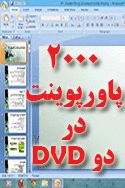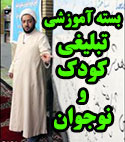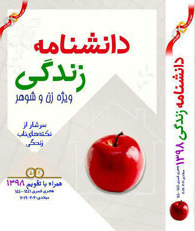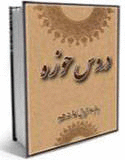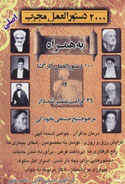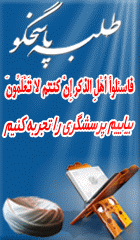Qal'e No-Kharaqan" village in Semnan Province
The mausoleum of a well-known learned scholar of the 4th and 5th lunar Hijri centuries, namely Sheikh Abol-Hassan Kharaqani provides the proof of this village's historical background. The village has been chosen by different Iranian ministries and organizations as a target village for tourism. And now we talk more about "Qal'e No-Kharaqan" village.
Qal'e No-Kharaqan village is a part of Bastam town from the city of Shahrood, and is situated 24 km east of Shahrood. Also known as Kharaqan, the village is on a mountain foot that is 1460 meters above the sea level. Qal'e No-Kharaqan is surrounded by the main top-line of Alborz mountain range from north and is located among the three mountains of Siah-Kooh on East, Zarin-Kooh on North East, and Kooh-Bidar on North West. This village has a fine moderate weather in springs and summers but it is cold in winters. A population of about 3000 people lives in Qal'e No-Kharaqan village; they are Shiite Muslims and speak Farsi with their local accent. Due to the fact that the great mystic, Sheikh Abol-Hassan Kharaqani was born and also lived in this village, it has been attended to by those fond of mysticism from the very past; many other mystics used to gather in the village to meet and confabulate with this sheikh.
Now we speak about the economy of Qal'e No-Kharaqan village. People mostly work in the fields of agriculture, animal husbandry, gardening, masonry, apiculture, and making handicrafts such as weaving rugs and carpets. The flora of the village consists of medicinal herbs such as borage, wild rue, and green meadows all around. Its agricultural products are potato, wheat, barley, corn, beetroot, and garden products like apricot, cherry, and grapes. All farms in this village are irrigated and no dry farming is practiced there. In hot seasons, animal breeders are used to take their cattle to summer resorts that are usually Borun-borun valley, Kooh-Bidar Mountain, and Maryam spring.
Qal'e No-Kharaqan is situated on a not-too-steep slope and has a dense residential texture. Rural houses with gable roofs, and thatch walls, in the heart of green fertile plains, have created beautiful sceneries. These houses are built with regards to natural conditions, and the life style and activities of the inhabitants. The materials used in construction of older houses are often clay, stone, adobe, wood, and brick, while newer ones are made of more resistant materials such as cement, bricks, chalk, and iron beams.
Due to its being located near the forests on the southern skirt of Alborz Mountain range, No-Kharaqan village enjoys many magnificent landscapes. Furthermore, valuable historic monuments have multiplied its attractiveness for tourists and travelers. It’s being green and having fine weather especially in springs and summers have made the village a beauty spot and also a tourist attraction site.
Borun-borun plain, whose name we mentioned earlier in this program, is another natural attraction of No-Kharaqan village with its cover of rich meadows, different colorful flowers, and beautiful plants. These rich meadows and numerous springs have made the plain a summer resort for No-Kharaqan tribes and clans; and as mentioned earlier, some inhabitants of the village move to this plain in order to feed their cattle and stay there for a period of 4 months. Travelers who take a trip to this worth-visiting plain, not only get to know more about tribal life in the region, but also make use of some fresh food products such as high-quality dairy, meat and bread.
On a short distance south of Borun-borun plain, or some 4 km North West of Qal'e No-Kharaqan village, Bidar Mountain and its valley are located. In addition to the lovely nature of its uneven surface, this area shares some of its features with Borun-borun plain.
Of the worth-visiting monuments of Qal'e No-Kharaqan village, mention can be made of a beautiful and historic complex in which the mausoleum of Sheikh Abol-Hassan Kharaqani is situated, remnants of a castle named Kohan-Qal'e dating back to the pre-Islamic period, a historic hill named Koli, an old water storage built in the architectural style of the Qajar period, an old public bath, and some more. The mausoleum of the well-known mystic of the 4th and 5th lunar Hijri centuries, Sheikh Abol-Hassan Kharaqani, is on a hill in the northern part of the village and is surrounded by several green hills that add to its attractiveness. Made of bricks, the building of the mausoleum has been constructed 37 years ago by Iran's National Monuments Association. On the tomb a piece of marble stone is installed on which some poems are carved. Beside the mausoleum there used to be a mosque with a cone-shaped dome decorated with beautiful tiles which dated back to the Ilkhanid era; but today there remains only its Mehrab or altar.
Source: irib.ir
مطالب مشابه با این موضوع:
وبگــــــــــردی طلبۀ پاسخگو
- فایل اعمال و رفتار های خلاف قانون جناب آقای حسن روحانی
- در کنج خانه طلبهها چه میگذرد؟
- سکوت چند ساله مسئولان حوزه در قبال حملات وحشیانه به طلاب!
- می گویند که مملکت مملکت آخوندهاست!!
- یک ماجرای تلخ که خانم ها با تأمل بیشتر بخونند
- جریان های تکفیری موجود در عراق و نحوه شکل گیری آنها
- سیر تکاملی تفکر سلفیه چگونه بوده است؟
- بداء در قرآن و حدیث چگونه مطرح شده است؟
- پیامبر (ص) با مخالفین خود چگونه بر خورد می کرد؟
- سبک زندگی حضرت زهرا سلام الله علیها
- ملاک کرامت و شرافت افراد، انسانیت است یا جنسیت؟
- رنگ و پوشش های رنگی در اسلام
- حجاب، زنان را افسرده میکند و مانع پیشرفت اجتماعی آنهاست!!!
- علوم لدنی معصومین
- مگر ولی فقیه معصوم است که ولایت مطلقه دارد؟
- اگر خدا ازعاقبت ما اطلاع دارد قیامت برای چیست؟
- آیا بجای نماز خوندن، پیانو یا سه تار بزنم؟
- چرا مراسم عزاداري امام حسين(ع) پيش از شهادت ايشان صورت ميگيرد؟
- چرا امام حسين(ع) در كربلا براي رفع تشنگي از خداوند طلب باران نكرد؟
دانــــــلود های مفیـــــــــــــــــــد
- دانلود پاورپوینت شناخت وهابیت و صهیونیسم و ارتباط با همدیگر
- دانلود دو پاورپوینت اجرای عید غدیر خم
- دانلود پاورپوینت احتجاج اميرمؤمنان (ع) به غدير
- پژوهشی در کلام و پیام مقام معظم رهبری پیرامون ماه رمضان
- خطبه شعبانیه و خطبه امیرالمومنین(علیه السلام) پیرامون روزه و ماه رمضان
- دانلود پاورپوینت و pdf تفاوت های زن و مرد
- دانلود جزوه ساعات سعد و نحس(زمان نوشتن دعا)
- تقویم مذهبی شمیم یار 96 مخصوص کامپیوتر
- دانلود نرم افزار «شیعه شناسی»
- دانلود پاورپوینت ساختار خانواده و مسایل آن
- دانلود کتاب دایره المعارف جنسی
- دانلود نکات جذاب دوران عقد
- دانلود کتاب درمان سرد مزاجی و بی میلی جنسی بانوان
- دانلود کتاب حسادت کودکان
- دانلود کتاب درمان خستگی وناتوانی جنسی
- دانلود پاور پوینت اسیب های ازدواج وخانواده
- دانلود پاورپوینت هشت گام برای تحقق رویا به واقعیت
- دانلود پاورپوینت تقویت اراده
- دانلود پاورپوینت موفقیت وروشهای رسیدن به ان
- دانلود پاورپوینت هنر رفتار با افراد دشوار
- دانلود پاورپوینت جملات جالب وجذاب روحیه بخش بزرگان
- دانلود پاورپوینت راههای مقابله ودرمان استرس
- دانلود پاورپوینت نیازهای اساسی کودکان
منبــــرهای مکــــــــــــــــــتوب
- منبر مکتوب: روز عرفه و فرصت ها
- منبر مکتوب: سبک زندگی امام باقر علیه السلام
- منبر مکتوب: سه نیاز مومن (امام جواد علیه السلام)
- سخنرانی سلسله ای و چند جلسه ای مناسبت ماه رمضان
- دانلود 30 جلسه سخنرانی ماه مبارک با موضوع تنها مسیر
- موضوعات پیشنهادی سخنرانی برای محرم
- فضائل حضرت قمر بنی هاشم علیه السلام
- برکات وجود ابا عبدالله علیه السلام بر عالم
- بررسی بُعد اخلاقی،عبادی و عرفانی عاشورا
- آخرين وصيت امام حسين عليه السلام
- اولین علت رویاروی در کربلا؛ دوری از یاد خدا
- هميشه حزن؟ شادي چرا نه؟ - شب دهم محرم
- چرا نفرين ؟ - شب نهم محرم
- نماز ظهر عاشورا - شب هشتم محرم
- فلسفه عزاداری - شب هفتم محرم
- دفاع از دین - شب ششم محرم
- فلسفه حضور خانواده سيد الشهداء - شب پنجم محرم
- علم امام علیه السلام به شهادت - شب چهارم محرم
- فقدان شرایط امر به معروف و نهی از منکر- شب سوم محرم
مناظرات طلبه پاسخگو
جدیدترین های زبان انگلیسی
- Islam and Its Social System
- Duties of Man Towards the People
- Islam Various Systems
- Attributes of The Real Follower of Imams in Their Teachings
- Who is a Real Shia Muslim?
- RIGHTS OF SCHOLARS
- Islam Attacks Slavery 1
- The Advantages of Religion 2
- The Clearest Reason for Free Will
- Sheikh Zakzaky to be released on bail
- Brief History of Religions
- Is It Necessary For Man To Follow A Religion?
- The Advantages of Religion 1
- Who Is Almighty Allah?
- What are the differences between Shia and Sunni Muslims؟
- The Rights Islam Offers to Women
- How I find that Islam does not Oppress Women?
- URGENT MEDICAL TREATMENT FOR SHEIKH ZAKZAKY
- The motto of this year’s book fair is “Reading Is Ability”.
- Fundamental principles of Islam
بیشترین دانلود ها
- دانلود صوتي تکنیک های نزدیکی زن و شوهر (108037)
- دانلود رایگان کتاب خواص سوره های قرآن (54713)
- دانلود پاورپوینت بسیار مفید مهارت های زندگی (37389)
- دانلود پاورپوینت و pdf تفاوت های زن و مرد (33719)
- دانلود كتاب مسائل جنسي و زناشوئي در احاديث (33716)
- دانلود کتاب دایره المعارف جنسی (31738)
- دانلود پاورپوینت های آموزش پیش از ازدواج (30468)
- دانلود بسیار مفید پاورپوینت آئین همسرداری (29821)
- دانلود پاورپوینت آموزشی بررسی رابطه دختر و پسر (29471)
- دانلود 110جلد کتاب بحارالانوار علامه مجلسی ره (29423)
- دانلود كتاب دختران خوب به آسمان می روند دختران بد به همه جا (28421)
- دانلود کتاب آموزش جنسی آقایان (28222)
- دانلود كتاب فرق و مذاهب كلامي استاد رباني گلپايگاني (28165)
- دانلود کتاب درمان سرد مزاجی و بی میلی جنسی بانوان (27944)
- دانلود نکات جذاب دوران عقد (27478)
- دانلود نرم افزار «شیعه شناسی» (25788)
- دانلود کتاب درمان خستگی وناتوانی جنسی (25059)
- دانلود پاورپوینت تقویت اراده (23541)
جدیدترین مطالب سایت
- پاسخ به شبهات ولایت (4643) بازدید
- پاسخ به شبهات ولایت (4434) بازدید
- اذان در جامعه اسلامی نماد چیست ؟ و چرا فقط سه بار در روز تکرار می شود ؟ (3869) بازدید
- باتوجه به عادل بودن خداوند چرا بعضی از انسانها را ناقص الخلقه آفریده است ؟ (3943) بازدید
- ویژگی خاص قرآن چیست که کسی نمی تواند مانند آن را بیاورد ؟ (4163) بازدید
- با توجه به ترک خود ارضایی عوارض آن هنوز در من هست چگونه آن را برطرف کنم ؟ (5565) بازدید
- آیا بدن اخروی مانند بدن مادی است ؟چهره ی واقعی انسان در قیامت چگونه است ؟ (4958) بازدید
- آیا ادعای ملاقات امام زمان (عج) از جانب برخی افراد صحت دارد ؟ (4461) بازدید
- چرا به اصول و قواعد دین اسلام توجه نمی شود و پذیرش آن از سوی پیروان ادیان دیگر سخت است ؟ (4825) بازدید
- فلسفه وجود لباس روحانیت در عصر حاضر چیست ؟ (3511) بازدید
- آیا وظیفه یک روحانی تنها راهنمایی مردم و فعالیت و تدریس در حوزه هاست ؟ (2924) بازدید
- آیا نظریه تناسخ از دیدگاه اسلام پذیرفته شده است ؟ (5173) بازدید
- آیا توصیف بهشت و جهنم در قرآن تمثیل هایی برای درک بهتر آن جهان است ؟ (4794) بازدید
- با توجه به اینکه اسلام کاملترین دین هست چرا ما نسبت به کشور های غیر مسلمان عقب مانده تر هستیم ؟ (6677) بازدید
- نقش امام و رهبر در جامعه اسلامی چیست ؟ و اگر نباشد چه اتفاقی می افتد ؟ (4503) بازدید
پربازدیدترین های سایت
- زنی هستم که میخواهم به شوهرم خیانت کنم!!! (605246)
- آيا زن شوهر دار بخاطر رفع نیاز جنسی اش ميتواند صیغه شود؟ (500940)
- دوست دخترم حامله شده چکار کنم؟ (398557)
- میل جنسی زیادی دارم و به شدت داره منو عذاب می ده (340453)
- دیدن فیلم های مبتذل زن و شوهر برای تحریک شدن جنسی (217782)
- چگونه همسرمان را آماده آميزش جنسي كنم؟+18 (213101)
- حکم شرعی نزدیکی از پشت! (207998)
- خانم هایی که می خواهند طلبه شوند بخوانند!!! (205434)
- زنم رابطه جنسی برقرار نمیکند!!! (199640)
- از تجربه های تلخ و تکان دهنده دختران بخوانید شاید... (172376)
- گناه با محارم خود داشتم! (146268)
- رابطه جنسی دهانی حكم چيست؟ (130692)
- محرمات و مکروهات و مستحبات حائض+حکم ورد به امکان مقدسه (129469)
- به رابطه خانمم با خواهر زاده اش مشکوکم؟ (123090)
- سفارش اسلام در مورد آمیزش صحیح چیست؟ (99028)
- نام كتاب حضرت نوح و حضرت ابراهیم؟ (97007)
- با زنان چشم سبز ازدواج نکنیم؟ (94702)












